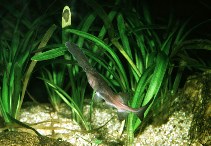http://www.fishbase.org/Summary/speciesSummary.php?genusname=Polyodon&speciesname=spathula ---> http://192.134.151.83/Summary/speciesSummary.php?genusname=Polyodon&speciesname=spathula
http://192.134.151.83/Summary/speciesSummary.php?genusname=Polyodon&speciesname=spathula ---> https://fishbase.mnhn.fr/Summary/speciesSummary.php?genusname=Polyodon&speciesname=spathula
https://fishbase.mnhn.fr/Summary/speciesSummary.php?genusname=Polyodon&speciesname=spathula ---> https://fishbase.mnhn.fr/summary/Polyodon-spathula.html
Polyodon spathula, Mississippi paddlefish : fisheries, aquarium

You can
sponsor
this page
Common name (e.g. trout)
Genus + Species (e.g. Gadus morhua)
-

-
About this page
-
Languages
-
User feedbacks
-
Citation
-
Uploads
-
Related species
-


 Mississippi paddlefish
Upload your
photos
and
videos
Mississippi paddlefish
Upload your
photos
and
videos
Pictures
|
Stamps, Coins Misc.
|
Google image
 Polyodon spathula
Polyodon spathula
Picture by
Moreau, J.
Chondrostei (sturgeons) >
Acipenseriformes
(Sturgeons and paddlefishes) >
Polyodontidae
(Paddlefishes)
Etymology:
Polyodon:
Greek, polys = a lot of + Greek, odous = teeth (Ref.
45335
)
;
spathula:
Polyodon
, many toothed, perhaps due to the numerous gill rakers because adult paddlefish lack teeth, although young fish has many small teeth, and
spathula
meaning spatula, due to its elongated snout (Ref.
79012
)
.
More on author:
Walbaum
.
Environment: milieu / climate zone / depth range / distribution range
Ecology
Freshwater; demersal; potamodromous (Ref.
51243
); depth range 2 - ? m. Subtropical; 10°C - 18°C (Ref.
2060
); 49°N - 29°N, 112°W - 77°W (Ref.
86798
)
North America: Mississippi River basin from southwestern New York to Montana and south to Louisiana; Gulf Slope drainagaes from Mobile Bay in Alabama, to Galveston Bay in Texas, USA. Formerly in Great Lakes basin, probably extirpated. At least one country reports adverse ecological impact after introduction.
Size / Weight / Age
Maturity: L
m
?
range ? - ? cm
Max length : 221 cm TL male/unsexed; (Ref.
86798
); common length : 120 cm TL male/unsexed; (Ref.
12193
); max. published weight: 90.7 kg (Ref.
3221
); max. reported age: 55 years (Ref.
46974
)
Snout long, canoe-paddle-shaped; gill cover with large, fleshy, pointed flap (Ref.
86798
).
Usually inhabits water deeper than 1.2 m in slow-flowing large rivers, lakes, and impoundments (Ref.
86798
). Feeds on plankton. The extended upper jaw (= paddle) may help to channel plankton into the mouth. Threatened due to over harvesting, habitat loss and pollution (Ref.
58490
).
Page, L.M. and B.M. Burr
, 2011. A field guide to freshwater fishes of North America north of Mexico. Boston : Houghton Mifflin Harcourt, 663p. (Ref.
86798
)
IUCN Red List Status (Ref.
130435
)
Vulnerable (VU)
(A2cd); Date assessed:
14 September 2019
CITES
Appendix II:
International trade monitored
Not Evaluated
Threat to humans
Human uses
Fisheries: commercial; aquarium: public aquariums
FAO - Fisheries:
landings
,
species profile
; Publication:
search
|
FishSource
|
More information
Countries
FAO areas
Ecosystems
Occurrences
Introductions
Stocks
Ecology
Diet
Food items
Food consumption
Ration
Common names
Synonyms
Metabolism
Predators
Ecotoxicology
Reproduction
Maturity
Spawning
Spawning aggregation
Fecundity
Eggs
Egg development
Age/Size
Growth
Length-weight
Length-length
Length-frequencies
Morphometrics
Morphology
Larvae
Larval dynamics
Recruitment
Abundance
BRUVS
References
Aquaculture
Aquaculture profile
Strains
Genetics
Electrophoreses
Heritability
Diseases
Processing
Nutrients
Mass conversion
Collaborators
Pictures
Stamps, Coins Misc.
Sounds
Ciguatera
Speed
Swim. type
Gill area
Otoliths
Brains
Vision
Tools
Bio-Quiz
|
E-book
|
Field guide
|
Length-frequency wizard
|
Life-history tool
|
Point map
|
Classification Tree
|
Catch-MSY
|
Special reports
Check for Aquarium maintenance
|
Check for Species Fact Sheets
|
Check for Aquaculture Fact Sheets
Download XML
Summary page
|
Point data
|
Common names
|
Photos
Internet sources
AFORO (otoliths) |
Alien/Invasive Species database
|
Aquatic Commons
|
BHL
|
Cloffa
|
BOLDSystems
|
Websites from users
|
Check FishWatcher
|
CISTI
|
Catalog of Fishes
:
genus
,
species
|
DiscoverLife
|
ECOTOX
| FAO - Fisheries:
landings
,
species profile
; Publication:
search
|
Faunafri
| Fishipedia |
Fishtrace
| GenBank:
genome
,
nucleotide
|
GloBI
|
Google Books
|
Google Scholar
|
Google
| IGFA World Record |
MitoFish
|
National databases
|
Otolith Atlas of Taiwan Fishes
|
Public aquariums
|
PubMed
| Reef Life Survey | Socotra Atlas |
Tree of Life
| Wikipedia:
Go
,
Search
|
World Records Freshwater Fishing
|
Zoological Record
Estimates based on models
Phylogenetic diversity index (Ref.
82804
): PD
50
= 1.2500 [Uniqueness, from 0.5 = low to 2.0 = high].
Bayesian length-weight: a=0.00646 (0.00430 - 0.00969), b=3.09 (2.98 - 3.20), in cm total length, based on LWR estimates for this species (Ref.
93245
).
Trophic level (Ref.
69278
): 3.4 ±0.45 se; based on food items.
Resilience (Ref.
120179
): Low, minimum population doubling time 4.5 - 14 years (tm=6-9; tmax=30).
Fishing Vulnerability (Ref.
59153
): Very high vulnerability (90 of 100).
Price category (Ref.
80766
):
Unknown
.
Nutrients (Ref.
124155
): Calcium = 29.6 [13.4, 59.0] mg/100g; Iron = 1.11 [0.65, 1.86] mg/100g; Protein = 18.1 [15.6, 20.7] %; Omega3 = 0.356 [0.139, 0.908] g/100g; Selenium = 71.4 [29.0, 167.5] μg/100g; VitaminA = 11.8 [3.6, 39.5] μg/100g; Zinc = 0.737 [0.499, 1.125] mg/100g (wet weight);
Back to Search
Random Species
Back to Top
Accessed through:
Not available
FishBase mirror site :
localhost
Page last modified by :
mrius-barile
- 20 July 2016
Fatal error
: Uncaught ArgumentCountError: Too few arguments to function checkEcotox(), 1 passed in /var/www/html/summary/speciessummary.php on line 2304 and exactly 3 expected in /var/www/html/includes/speciessummary.lib.php:2579 Stack trace: #0 /var/www/html/summary/speciessummary.php(2304): checkEcotox() #1 {main} thrown in
/var/www/html/includes/speciessummary.lib.php
on line
2579
|